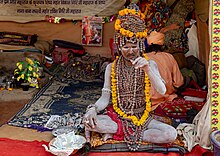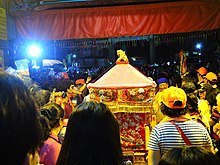Pilgrimage

A pilgrimage is a journey to a holy place, which can lead to a personal transformation, after which the pilgrim returns to their daily life.[1][2][3]
Background
Pilgrimages frequently involve a journey or search of moral or spiritual significance. Typically, it is a journey to a shrine or other location of importance to a person's beliefs and faith, although sometimes it can be a metaphorical journey into someone's own beliefs.
Many religions attach spiritual importance to particular places: the place of birth or death of founders or saints, or to the place of their "calling" or spiritual awakening, or of their connection (visual or verbal) with the divine, to locations where miracles were performed or witnessed, or locations where a deity is said to live or be "housed," or any site that is seen to have special spiritual powers. Such sites may be commemorated with shrines or temples that devotees are encouraged to visit for their own spiritual benefit: to be healed or have questions answered or to achieve some other spiritual benefit.
A person who makes such a journey is called a pilgrim. As a common human experience, pilgrimage has been proposed as a Jungian archetype by Wallace Clift and Jean Dalby Clift.[4] Some research has shown that people who engage in pilgrimage walks have biological, psychological, social, and spiritual therapeutic benefits.[5]
The
The Catholic priest Frank Fahey writes that a pilgrim is "always in danger of becoming a tourist," and vice versa since travel always in his view upsets the fixed order of life at home, and identifies eight differences between the two:[7]
| Element | Pilgrimage | Tourism |
|---|---|---|
| Faith | always contains "faith expectancy" | not required |
| Penance | search for wholeness | not required |
| Community | often solitary, but should be open to all | often with friends and family, or a chosen interest group |
| Sacred space | silence to create an internal sacred space | not present |
| Ritual | externalizes the change within | not present |
| Votive offering | leaving behind a part of oneself, letting go, in search of a better life | not present; the travel is the good life |
| Celebration | "victory over self", celebrating to remember | drinking to forget |
| Perseverance | commitment; "pilgrimage is never over" | holidays soon end |
Ancient Greece
The
Bahá'í Faith
Buddhism

In
- Lumbini: Buddha's birthplace (in Nepal)
- Enlightenment (in the current Mahabodhi Temple, Bihar, India)
- Sarnath: (formally Isipathana, Uttar pradesh, India) where he delivered his first sermon (Dhammacakkappavattana Sutta), and the Buddha taught about the Middle Way, the Four Noble Truths and Noble Eightfold Path
- mahaparinirvana(died)
Other pilgrimage places in India and Nepal connected Gautama Buddha's life are:
Other famous places for Buddhist pilgrimage include:
- India: Sanchi, Ellora Caves, Ajanta Caves, also see Buddhist pilgrimage sites in India
- Ayutthaya
- Lake Nam-tso
- Cambodia: Wat Botum, Wat Ounalom, Wat Botum, Silver Pagoda, Angkor Wat
- Sri Lanka: Temple of the Tooth, Polonnaruwa, (Kandy), Anuradhapura
- Laos: Pha That Luang, Luang Prabang
- Malaysia: Kek Lok Si, KL Buddhist Maha Vihara
- Myanmar: Shwedagon Pagoda, Mahamuni Buddha Temple, Kyaiktiyo Pagoda, Bagan, Sagaing Hill, Mandalay Hill,
- Nepal: Maya Devi Temple, Boudhanath, Swayambhunath
- Indonesia: Borobudur, Mendut, Sewu
- Taiwan: Fo Guang Shan, Dharma Drum Mountain, Chung Tai Shan, Tzu Chi
- Hong Kong: Po Lin Monastery
- Four Sacred Mountains
- Japan:
- Shikoku Pilgrimage, 88 temple pilgrimage on the island of Shikoku
- Japan 100 Kannon Pilgrimage, pilgrimage composed of the Saigoku, Bandō and Chichibu pilgrimages
- Kansairegion
- Bandō Sanjūsankasho, pilgrimage in the Kantō region
- Chichibu 34 Kannon Sanctuary, pilgrimage in Saitama Prefecture
- Chūgoku 33 Kannon Pilgrimage, pilgrimage in the Chūgoku region
- Kumano Kodō
- Mount Kōya
Christianity


Christian pilgrimage was first made to sites connected with the birth, life, crucifixion and resurrection of
The purpose of Christian pilgrimage was summarized by Pope Benedict XVI in this way:
To go on pilgrimage is not simply to visit a place to admire its treasures of nature, art or history. To go on pilgrimage really means to step out of ourselves in order to encounter God where he has revealed himself, where his grace has shone with particular splendour and produced rich fruits of conversion and holiness among those who believe. Above all, Christians go on pilgrimage to the Holy Land, to the places associated with the Lord's passion, death and resurrection. They go to Rome, the city of the martyrdom of Peter and Paul, and also to Compostela, which, associated with the memory of Saint James, has welcomed pilgrims from throughout the world who desire to strengthen their spirit with the Apostle's witness of faith and love.[11]
Pilgrimages were, and are, also made to
Hinduism

According to Karel Werner's Popular Dictionary of Hinduism, "most Hindu places of pilgrimage are associated with legendary events from the lives of various gods.... Almost any place can become a focus for pilgrimage, but in most cases they are sacred cities, rivers, lakes, and mountains."[12] Hindus are encouraged to undertake pilgrimages during their lifetime, though this practice is not considered absolutely mandatory. Most Hindus visit sites within their region or locale.

- Kumbh Mela: .
- (four abodes) pilgrimage circuit.
- Shiva shrines.[16]
- Old Holy cities per Puranic Texts: Varanasi also known as Kashi (Shiva), Prayagraj, Haridwar-Rishikesh (Vishnu), Mathura-Vrindavan (Krishna), Pandharpur (Krishna), Paithan, Kanchipuram (Parvati), Dwarka (Krishna) and Ayodhya (Rama).
- Major Temple cities: Sabarimala, where Ayyappanis worshipped.
- Shakti Pithas: Another important set of pilgrimages are the Shakti Pithas, where the Mother Goddess is worshipped, the two principal ones being Kalighat and Kamakhya.
- Pancha Ishwarams - the five ancient Shiva temples of Sri Lanka from classical antiquity.
- The Katirkamamin the South.
Islam
The
Another important place for Muslims is the city of Medina, the second holiest site in Islam, in Saudi Arabia, the final resting place of Muhammad in
The Ihram (white robe of pilgrimage) is meant to show equality of all Muslim pilgrims in the eyes of Allah. 'A white has no superiority over a black, nor a black over a white. Nor does an Arab have superiority over a non-Arab, nor a non-Arab over an Arab - except through piety' - statement of the Prophet Muhammad.
About four million pilgrims participate in the Grand Magal of Touba, 200 kilometres (120 mi) east of Dakar, Senegal. The pilgrimage celebrates the life and teachings of Cheikh Amadou Bamba, who founded the Mouride brotherhood in 1883 and begins on the 18th of Safar.[25]
Shia
Al-Arba‘īn (
The second largest holy city in the world,
Judaism
While
The western retaining wall of the
There are numerous lesser Jewish pilgrimage destinations, mainly tombs of tzadikim, throughout Israel and Palestine and all over the world, including: Hebron; Bethlehem; Mount Meron; Netivot; Uman, Ukraine; Silistra, Bulgaria; Damanhur, Egypt; and many others.[34]
Many rabbis claim that even today, after the destruction of the Temple, there is a mitzvah to make a pilgrimage on holidays.[35]
Sikhism
Sikhism does not consider pilgrimage as an act of spiritual merit. Guru Nanak went to places of pilgrimage to reclaim the fallen people, who had turned ritualists. He told them of the need to visit that temple of God, deep in the inner being of themselves. According to him: "He performs a pilgrimage who controls the
Eventually, however,
The
Taoism

Mazu, also spelled as Matsu, is the most famous sea goddess in the Chinese southeastern sea area, Hong Kong, Macau and Taiwan.
Mazu Pilgrimage is more likely as an event (or temple fair), pilgrims are called as "Xiang Deng Jiao" (pinyin: xiāng dēng jiǎo, it means "lantern feet" in Chinese), they would follow the Goddess's (Mazu) palanquin from her own temple to another Mazu temple. By tradition, when the village Mazu palanquin passes, the residents would offer free water and food to those pilgrims along the way.
There are 2 main Mazu pilgrimages in Taiwan, it usually hold between lunar January and April, depends on Mazu's will.
- Baishatun Mazu Pilgrimage: this pilgrimage can be traced to 1863, from Baishantun (Miaoli County) to Beigang (Yunlin County) and return, not over a definite route.[40]
- Dajia Mazu Pilgrimage: from Dajia (Taichung City) to Xingang (Chiayi County) and return, it runs over a definite route.[41]
Zoroastrianism
In
Atash Behram ("Fire of victory") is the highest grade of fire temple in Zoroastrianism. It has 16 different "kinds of fire", that is, fires gathered from 16 different sources.[43] Currently there are 9 Atash Behram, one in Yazd, Iran and the rest in Western India. They have become a pilgrimage destination.[44]
In India the cathedral fire temple that houses the
Other
Meher Baba
The main pilgrimage sites associated with the spiritual teacher
See also
- Burial places of founders of world religions
- HCPT – The Pilgrimage Trust
- Hiking
- Journey of self-discovery
- Junrei
- List of shrines
- List of significant religious sites
- Monastery
- New Age travellers
- Pardon (ceremony)
- Religion in pre-Islamic Arabia § Pilgrimages
- Romeria
- Sacred travel
- World Youth Day
- Eastbridge Hospital of St Thomas the Martyr, Canterbury
- Russian wandering
References
- OCLC 935188979.
- )
- S2CID 170484577.
- ISBN 0-8091-3599-X.
- S2CID 143623445.
- Stockholm University School of Business. Archived from the original(PDF) on 26 January 2020. Retrieved 1 July 2011.
- ^ JSTOR 27664505.
- .
- ^ ISBN 1-85168-184-1.
- S2CID 170884065.
- ^ "Apostolic Journey to Santiago de Compostela and Barcelona: Visit to the Cathedral of Santiago de Compostela (November 6, 2010) | BENEDICT XVI".
- ISBN 0700702792. Retrieved 30 October 2016.
- ^ Thangham, Chris V. (3 January 2007). "Photo from Space of the Largest Human Gathering in India". Digital Journal. Retrieved 22 March 2014.
- ^ Banerjee, Biswajeet (15 January 2007). "Millions of Hindus Wash Away Their Sins". The Washington Post. Retrieved 22 March 2014.
- ^ "Millions bathe at Hindu festival". BBC News. 3 January 2007. Retrieved 22 March 2014.
- ^ Singh, Vikas (2017). Uprising of the Fools: Pilgrimage as Moral Protest in Contemporary India. Stanford University Press.
- ISBN 978-0-7614-7926-0. Retrieved 2 September 2014.
- ISBN 0-253-21627-3.
- ^ "Islamic Practices". Berkley Center for Religion, Peace & World Affairs. Retrieved 7 April 2017.
- ISBN 9781596270169. Retrieved 18 September 2014.
- ^ Katz, Andrew (16 October 2013). "As the Hajj Unfolds in Saudi Arabia, A Deep Look Inside the Battle Against MERS". Time. Retrieved 17 October 2013.
- ^ a b "The world's largest Muslim pilgrimage site? Not Mecca, but the Shiite shrine in Karbala". Religion News Service. 9 September 2020. Retrieved 14 September 2020.
- ^ "Hajj Begins in Saudi Arabia Under Historic COVID Imposed Restrictions | Voice of America - English". www.voanews.com. VOA. 29 July 2020. Retrieved 14 September 2020.
- ISBN 9835203733. Retrieved 30 October 2016.
- ^ Holloway, Beetle (21 November 2018). "Senegal's Grand Magal of Touba: A Pilgrimage of Celebration". Culture Trip. Retrieved 14 September 2020.
- ^ uberVU – social comments (5 February 2010). "Friday: 46 Iraqis, 1 Syrian Killed; 169 Iraqis Wounded - Antiwar.com". Original.antiwar.com. Retrieved 30 June 2010.
- ^ Aljazeera. "alJazeera Magazine – 41 Martyrs as More than Million People Mark 'Arbaeen' in Holy Karbala". Aljazeera.com. Retrieved 30 June 2010.
- ^ "Powerful Explosions Kill More Than 40 Shi'ite Pilgrims in Karbala". Voanews.com. 5 February 2010. Retrieved 30 June 2010.
- ^ Hanun, Abdelamir (5 February 2010). "Blast in crowd kills 41 Shiite pilgrims in Iraq". News.smh.com.au. Retrieved 30 June 2010.
- ^ "Sacred Sites: Mashhad, Iran". sacredsites.com. Archived from the original on 27 November 2010. Retrieved 13 March 2006.
- )
- ^ "The Western Wall". mosaic.lk.net. Retrieved 6 June 2017.
- ^ "The Western Wall: History & Overview". www.jewishvirtuallibrary.org. Retrieved 27 March 2018.
- ^ See David M. Gitlitz and Linda Kay Davidson, Pilgrimage and the Jews (Westport, CT: Praeger, 2006) for history and data on several pilgrimages to both Ashkenazi and Sephardic holy sites.
- Peninei Halakha
- ^ Mansukhani, Gobind Singh (1968). Introduction to Sikhism: 100 Basic Questions and Answers on Sikh Religion and History. India Book House. p. 60.
- ISBN 9781441103581.
- ^ "Sikhism". Archived from the original on 23 November 2001.
- ^ "Special train to connect all five Takhats, first run on February 16". The Times of India. 5 February 2014. Retrieved 5 February 2014.
- ^ "沒固定路線、全憑神轎指引徒步400里...白沙屯媽祖進香有何秘密?他爆出這些「神蹟」超驚奇". The Storm Media (in Chinese (Taiwan)). Central News Agency (published 19 April 2018). 21 May 2018. Retrieved 6 June 2018.
{{cite web}}: CS1 maint: others (link) - ^ "~ 大甲媽祖遶境進香歷史沿革、陣頭、典禮、禁忌的介紹~". 淨 空 禪 林 (in Chinese (Taiwan)). 21 May 2018.
- ^ Aspandyar Sohrab Gotla (2000). "Guide to Zarthoshtrian historical places in Iran." University of Michigan Press. LCCN 2005388611 pg. 164
- ISBN 9004062084.
- ^ a b Shelar, Jyoti (1 December 2017). "Pilgrimage or mela? Parsis split on Udvada festival". The Hindu. Retrieved 21 December 2017.
- ^ Deshmukh, Indumati (1961). "Address in Marathi." The Awakener 7 (3): 29.
Further reading
- Coleman, Simon. Powers of Pilgrimage: Religion in a World of Movement. United States, NYU Press, 2022.
- al-Naqar, Umar. 1972. The Pilgrimage Tradition in West Africa. Khartoum: Khartoum University Press. [includes a map 'African Pilgrimage Routes to Mecca, ca. 1300–1900']
- Coleman, Simon and John Elsner (1995), Pilgrimage: Past and Present in the World Religions. Cambridge: Harvard University Press.
- Coleman, Simon & John Eade (eds) (2005), Reframing Pilgrimage. Cultures in Motion. London: Routledge.
- Davidson, Linda Kay and David M. Gitlitz (2002), Pilgrimage: From the Ganges to Graceland: An Encyclopedia. Santa Barbara, Ca.: ABC-CLIO.
- Gitlitz, David M. and Linda Kay Davidson (2006). Pilgrimage and the Jews. Westport, CT: Praeger.
- Jackowski, Antoni. 1998. Pielgrzymowanie [Pilgrimage]. Wroclaw: Wydawnictwo Dolnoslaskie.
- Kerschbaum & Gattinger, Via Francigena – DVD – Documentation, of a modern pilgrimage to Rome, ISBN 3-200-00500-9, Verlag EUROVIA, Vienna 2005
- Margry, Peter Jan (ed.) (2008), Shrines and Pilgrimage in the Modern World. New Itineraries into the Sacred. Amsterdam: Amsterdam University Press.
- Okamoto, Ryosuke (2019). Pilgrimages in the Secular Age: From El Camino to Anime. Tokyo: Japan Publishing Industry Foundation for Culture.
- Sumption, Jonathan. 2002. Pilgrimage: An Image of Mediaeval Religion. London: Faber and Faber Ltd.
- Wolfe, Michael (ed.). 1997. One Thousands Roads to Mecca. New York: Grove Press.
- Zarnecki, George (1985), The Monastic World: The Contributions of The Orders. pp. 36–66, in Evans, Joan (ed.). 1985. The Flowering of the Middle Ages. London: Thames and Hudson Ltd.
- Zwissler, Laurel (2011). "Pagan Pilgrimage: New Religious Movements Research on Sacred Travel within Pagan and New Age Communities". Religion Compass. 5 (7). Wiley: 326–342. ISSN 1749-8171.
External links
 Media related to Pilgrimage at Wikimedia Commons
Media related to Pilgrimage at Wikimedia Commons

